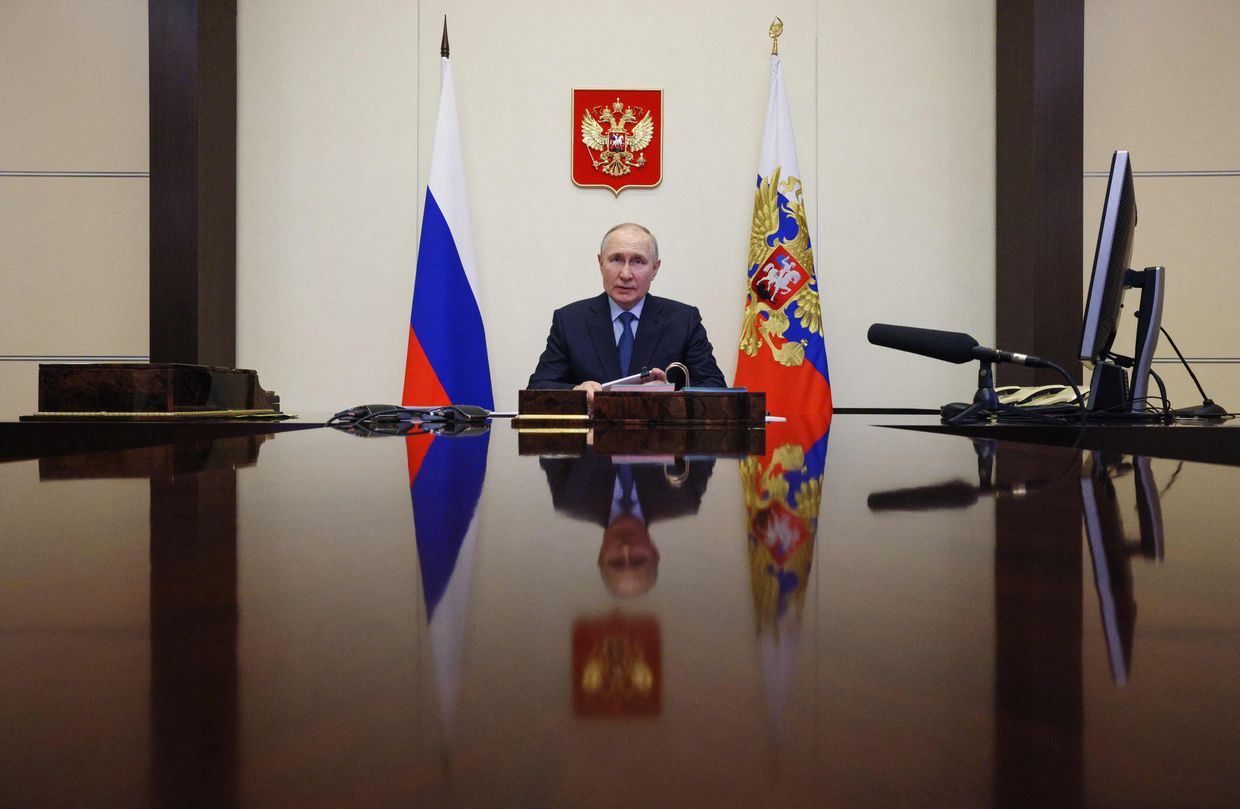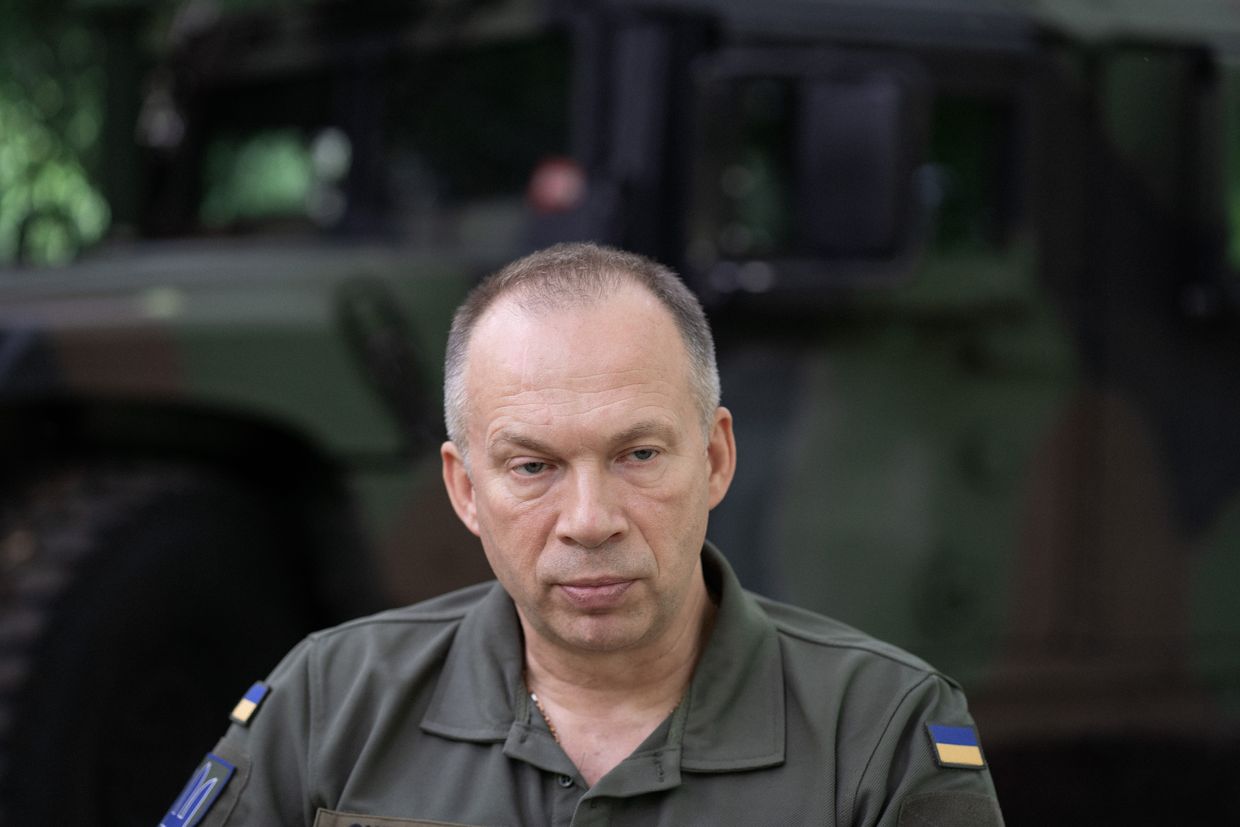Ukraine war latest: Ukraine confirms striking 2 large Russian landing ships; Russia launches major attack on energy system
Key developments on March 24:
- Ukraine confirms striking 2 large Russian landing ships in occupied Crimea
- Russia launches major attack across Ukraine targeting critical infrastructure
- ISW: Russia makes limited advances along eastern front
- Ministry: Situation at Zaporizhzhia's Dnipro Dam under control, no danger of breach
Ukraine struck two Russian Ropucha-class landing ships, "Yamal" and "Azov," in occupied Crimea in the late hours of March 23, Ukraine's Armed Forces confirmed on March 24.
The attack also hit some Black Sea Fleet infrastructure in Crimea and a Russian military communication center, the Ukrainian military said.
In recent months, Ukraine has intensified its attacks on occupied Crimea, targeting Russian military assets in and around the Black Sea. Russia has illegally occupied the peninsula since 2014.
"Yamal," with 98 crew members, and "Azov," with 87 crew members, belong to the 197th Landing Ships Brigade of the Russian Black Sea Fleet and are actively used in the fleet’s exercises and training, according to the fleet’s website.
The extent of the destruction on the ships is not yet clear.
The Russian Defense Ministry has not yet commented on Ukraine's reports of the successful strike.
Ropucha class (Project 775) is a NATO label for ships that were built at Gdansk’s Stocznia Polnocna Shipyard in Poland during the Cold War and support sea-to-land military assault operations.
As of February, only five Ropucha-class landing ships remained in service in Russia's Black Sea Fleet out of a previous total of 13 following the sinking of the Caesar Kunikov on Feb. 14, Ukrainian Navy spokesperson Dmytro Pletenchuk said on television.
Air raid sirens went off in Sevastopol on the evening of March 23, with Russia's illegal administration in Sevastopol temporarily blocking vehicle traffic on the Crimean Bridge. It later claimed Russian forces had shot down more than 10 missiles.
Mikhail Razvozhaev, the head of Sevastopol's illegal Russian occupation government, called the attack "the most massive" in recent time, claiming that one person was killed and four were injured as a result.
As Ukraine's campaign against Russia's navy continues, Russia is redeploying its Black Sea Fleet from occupied Crimea to the relative safety of Novorossiysk, Ukraine’s military intelligence (HUR) reported on March 21.
The Strategic Communications Center of the Armed Forces of Ukraine (StratCom) recently reported that as of early February 2024, 33% of the fleet’s warships had been disabled including 24 ships and one submarine.
Russia has taken a number of steps to address the continuing threat, including replacing the commander of the Russian Navy earlier this month.
On March 17, Russian Defense Minister Sergei Shoigu on a visit to Sevastopol said Black Sea Fleet ships would be armed with heavy-caliber machine guns to help destroy Ukrainian sea drones.
Referencing Russia’s new push to protect its ships, Yusov said that Ukraine’s future attacks will not necessarily be a repetition of previous operations.
“These will be new combined steps in the air, at sea, and on land.”

Russia launches major attack across Ukraine targeting critical infrastructure
Russia launched a major missile and drone attack across Ukraine early on March 24, targeting critical infrastructure and leaving thousands without heating, local governors reported.
Russian forces fired 29 cruise missiles and 28 Shahed drones in a large-scale attack targeting eight regions in the west, center, north, and south of Ukraine, the Air Force said. Of the total air targets fired across Ukraine, 18 cruise missiles and 25 Shahed drones were intercepted by the air defense, according to the report.
No casualties were reported as of 10 a.m. local time.
Russia has recently once again intensified its attacks against Ukraine's critical infrastructure, with the March 22 strike damaging the Dnipro Hydroelectric Power Plant, Ukraine's largest hydroelectric station.
Kyiv was among Russia’s targets. Approximately 10 missiles targeting Kyiv were shot down, according to the Kyiv City Military Administration. Debris of the shot-down missiles fell on two districts, in the eastern and central parts of the capital, without major destruction on residential areas, it added.
Western Lviv Oblast was also struck in the mass strike. Russia attacked an unnamed critical infrastructure site in Lviv Oblast using missiles and drones, causing a fire at the site, regional governor Maksym Kozytskyi reported.
The Air Force branch in charge of western Ukraine reported shooting down eight of the 19 cruise missiles fired, as well as all seven Shahed drones.
Russia once again targeted critical infrastructure during the second air raid alert that went off at around 9:30 a.m., a few hours after the countrywide strike overnight, attacking Lviv Oblast with Kinzhal air-launched missiles, according to Kozytskyi.
There were “two hits” recorded at the critical infrastructure site where the fire had erupted, but the firefighters who had been working after the major strike overnight were evacuated to a safe space on time, he added.
Firefighters in Lviv Oblast extinguished the fire at the infrastructure facility after a grueling battle against the blaze that lasted for hours, Kozytskyi reported past 5 p.m.
Central-eastern Dnipropetrovsk Oblast also suffered an attack on critical infrastructure.
Dnipropetrovsk Oblast Governor Serhii Lysak reported that the Russian attack drones targeted critical infrastructure in the city of Kryvyi Rih and in the Nikopol district.
In Kryvyi Rih, a city of around 600,000, the attack damaged heating networks and power lines, according to Lysak.
Six hospitals, more than 150 educational institutions, and 3,000 residential buildings home to 76,000 people were left without heating, he added. One of the medical facilities briefly lost power.
In southern Odesa Oblast, the strike damaged a port infrastructure in the region, according to the Southern Defense Forces. The regional governor has not yet reported the destruction.
Kherson, Mykolaiv, Sumy, and Volyn oblasts were other Ukrainian regions above which air targets were shot down, according to the Air Force.
Russian forces launched the latest mass strike from occupied Crimea and Russia, with cruise missiles being fired from 14 Tu-95 strategic bombers from around Engels in Russia’s Saratov Oblast in the country’s west, it added. The cruise missiles fired at Kyiv were launched from the north, according to local authorities.
Neighboring NATO member Poland said that a missile had once again briefly entered its airspace during the Russian attack.
One of the Russian cruise missiles targeting western Ukraine flew into Polish airspace for about 39 seconds at 4:23 a.m., Polish Air Force's Operational Command said on X.
"All necessary procedures aimed at ensuring the safety of Polish airspace have been activated, and the Operational Command of the Polish Air Force is monitoring the situation continuously," the Polish Armed Forces said.
The command said that it knew that the missile would circle back to Ukraine and decided not to down it.
Poland will demand explanations from Moscow after the Russian missile violated Polish airspace during the mass attack against Ukraine on the morning of March 24, the Polish Foreign Ministry later said.
Throughout the winter of 2022-2023, Russia launched a series of mass missile and drone strikes against Ukraine's critical infrastructure facilities, killing dozens of civilians and causing rolling blackouts nationwide. That winter, Russia severely hit almost half of the country's energy system.
The winter of 2023-2024 spelled yet another wave of massive strikes, but the resulting energy disruptions have not reached the scale of those in late 2022 and early 2023. Russia's attacks this year have for the most part failed to disrupt en masse the country's power grid.
ISW: Russia makes limited advances along eastern front
Russian forces have made "marginal advances" amid ongoing fighting in several positions in Donetsk and Zaporizhzhia oblasts, the U.S.-based think tank Institute for the Study of War (ISW) said in its latest report on March 23.
In Donetsk Oblast, the ISW claims that geolocated footage published on March 11 and geolocated on March 23 shows Russia's marginal advance north of Novomykhailivka, southwest of the city of Donetsk. The analysts noted that the advances were likely not recent.
Russia has also recently advanced west of Avdiivka in Donetsk Oblast, near the village of Tonenke, where geolocated footage confirms Russian forces recently made limited gains.
Avdiivka, a city in Donetsk Oblast that has been on the front line of the war since 2014, fell on Feb. 17, in what was Russia’s first major military gain in nine months.
Several villages west of Avdiivka were captured soon after as Ukraine faced a severe ammunition shortage while U.S. aid continued to be stalled in Congress. On March 15, Commander-in-Chief Oleksandr Syrskyi said Russian forces are concentrating their main efforts on making a breakthrough near the recently fallen city.
The ISW also reported that Russian forces marginally advanced in western Zaporizhzhia Oblast, capturing limited positions alongside the village of Verbove, east of Robotyne, with Russian units storming Ukrainian positions at dawn.
Russian forces have also reportedly increased their use of chlorobenzylidenemalononitrile (CS) gas, a chemical agent prohibited by the Chemical Weapons Convention, to which Russia is a signatory.
Commander-in-Chief Syrskyi said on March 21 that Ukrainian forces had managed to "stabilize the situation" in the country's east.
Russian forces have not yet demonstrated an ability to secure significant gains across large swaths of territory, the Institute for the Study of War assessed last month.
Ministry: Situation at Zaporizhzhia's Dnipro Dam under control, no danger of breach
The situation at Zaporizhzhia's Dnipro Dam is under control, and there is no danger of a breach following a Russian missile attack, the Environment Ministry said on March 23.
The Dnipro Hydroelectric Power Plant, Ukraine's largest hydroelectric station, was hit with eight Russian missiles on March 22 during the biggest attack on the country's energy infrastructure since the beginning of the full-scale invasion.
The Hydroelectric Power Station-2 (HPS-2), one of the two stations of Zaporizhzhia's Dnipro Hydroelectric Power Plant, is in critical condition following the attack. The dam itself suffered damage as well, but officials said already on March 22 that there was no risk of a breach.
Representatives of state and regional authorities held a coordination meeting regarding the potential environmental impacts of the attack on March 23.
According to the State Environmental Inspectorate's conclusions, the concentration of petroleum products in the water has decreased. Water intake has been suspended in the Bilenke community, the only area that draws water from the lower reaches of the Dnipro River.
The Inspectorate estimated the cost of damages to water resources at Hr 159,305 ($4,100). Damages caused by soil and air pollution are still being calculated.
Last year, Russian forces destroyed the Kahkovka Dam and the adjacent hydroelectric station located downstream of the Dnipro Dam, causing a humanitarian and ecological catastrophe across southern Ukraine.













